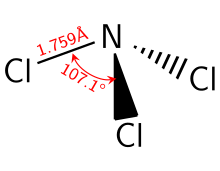
| |
 | |

| |
| Names | |
|---|---|
| Other names
Trichloramine
Agene Nitrogen(III) chloride Trichloroazane Trichlorine nitride | |
| Identifiers | |
3D model (JSmol)
|
|
| ChEBI | |
| ChemSpider | |
| ECHA InfoCard | 100.030.029 |
| EC Number |
|
| 1840 | |
PubChem CID
|
|
| RTECS number |
|
| UNII | |
CompTox Dashboard (EPA)
|
|
| |
| |
| Properties | |
| NCl3 | |
| Molar mass | 120.36 g·mol−1 |
| Appearance | yellow oily liquid |
| Odor | chlorine-like |
| Density | 1.653 g/mL |
| Melting point | −40 °C (−40 °F; 233 K) |
| Boiling point | 71 °C (160 °F; 344 K) |
| immiscible slowly decomposes | |
| Solubility | soluble in benzene, chloroform, CCl4, CS2, PCl3 |
| Structure | |
| orthorhombic (below −40 °C) | |
| trigonal pyramidal | |
| 0.6 D | |
| Thermochemistry | |
Std enthalpy of
formation (ΔfH⦵298) |
232 kJ/mol |
| Hazards | |
| NFPA 704 (fire diamond) | |
| 93 °C (199 °F; 366 K) | |
| Related compounds | |
Other anions
|
Nitrogen trifluoride Nitrogen tribromide Nitrogen triiodide |
Other cations
|
Phosphorus trichloride Arsenic trichloride |
Related chloramines
|
Monochloramine Dichloramine |
Related compounds
|
Nitrosyl chloride |
Except where otherwise noted, data are given for materials in their standard state (at 25 °C [77 °F], 100 kPa).
| |
Nitrogen trichloride, also known as trichloramine, is the chemical compound with the formula NCl3. This yellow, oily, and explosive liquid is most commonly encountered as a product of chemical reactions between ammonia-derivatives and chlorine (for example, in swimming pools). Alongside monochloramine and dichloramine, trichloramine is responsible for the distinctive 'chlorine smell' associated with swimming pools, where the compound is readily formed as a product from hypochlorous acid reacting with ammonia and other nitrogenous substances in the water, such as urea from urine.[1]
- ^ "Chlorine Chemistry - Chlorine Compound of the Month: Chloramines: Understanding "Pool Smell"". American Chemistry Council. Retrieved 17 December 2019.
